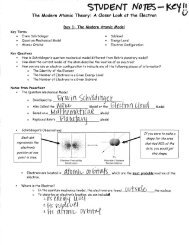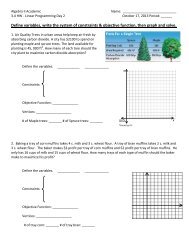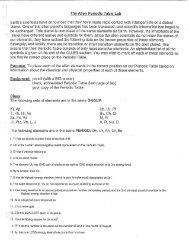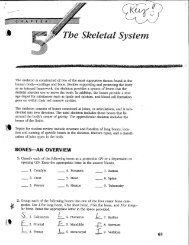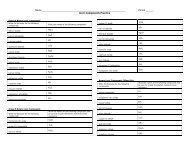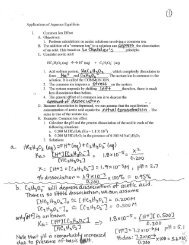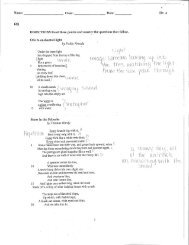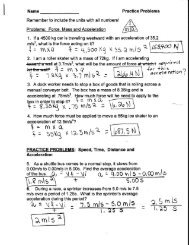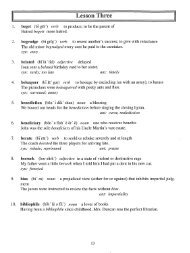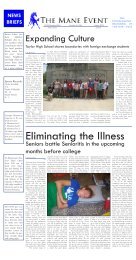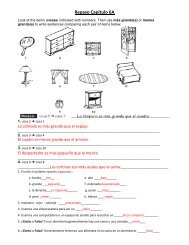Archetype Notes.pdf
Archetype Notes.pdf
Archetype Notes.pdf
Create successful ePaper yourself
Turn your PDF publications into a flip-book with our unique Google optimized e-Paper software.
Kruse/Westby- English I Pre-AP/GT<br />
<strong>Archetype</strong> <strong>Notes</strong><br />
An archetype is an image, a descriptive detail, a plot pattern, or a character type<br />
that occurs frequently in literature, mythology, and folklore.<br />
Character <strong>Archetype</strong>s:<br />
1. The Hero:<br />
(The hero may exhibit some or all of the following characteristics)<br />
o The circumstances of his birth are unusual<br />
o After birth, an attempt may be made on his life<br />
o Raised by foster parents<br />
o Little is known of his childhood<br />
o Upon reaching manhood he returns to his kingdom<br />
o After victory over the king or a beast, he comes king, marries a princess, and rules<br />
uneventfully<br />
o Loses favor with the gods and is driven from the city<br />
o Meets a mysterious death, often at the top of a hill<br />
o Body is not buried, but he has one or more burial vaults<br />
The hero can be female. In this case, she would be referred to as the heroine.<br />
2. The Young Man from the Provinces:<br />
This archetype refers specifically to the hero that is spirited away as a young man and reared by<br />
strangers. He later returns to his home and heritage where he is a stranger, able to see the<br />
problems faced by his new community and come up with solutions.<br />
3. The Initiates:<br />
These are young heroes or heroines who must endure some training and ceremony. They are<br />
innocent and often wear white.<br />
4. Mentors:<br />
These individuals serve as teachers or counselors to the initiates. They are role models and<br />
often serve as a father or mother figure.<br />
5. Mentor-Pupil Relationship:<br />
In this relationship, the mentor teaches the skills necessary to survive the quest.<br />
6. Father-Son Conflict:<br />
Tensions between father and son resulting from separation during childhood (or from some<br />
other external source).<br />
7. Hunting Group of Companions:<br />
Companions willing to face any number of perils in order to be together.<br />
8. Loyal Retainers:<br />
The duty of these individuals is to protect the hero and reflect the nobility of the hero. The loyal<br />
retainer is often, though not always, a servant to the hero.<br />
1
Kruse/Westby- English I Pre-AP/GT<br />
9. Friendly Beasts:<br />
An animal that is friendly to the hero. The relationship between a hero and friendly beast shows<br />
that nature is on the side of the hero.<br />
10. The Devil Figure:<br />
This character is the embodiment of evil. The devil figure offers worldly goods, fame, or<br />
knowledge to the protagonist in exchange for possession of his soul.<br />
11. The Evil Figure with the Ultimately Good Heart :<br />
A redeemable devil figure saved by the nobility or love of the hero.<br />
12. The Scapegoat:<br />
An animal or human whose death in a public ceremony makes amends for some taint or sin that<br />
has been visited upon a community. Their death often makes them a more powerful force in<br />
the society than when they lived.<br />
13. The Outcast:<br />
A figure that is banished from a social group for some crime (real or imagined) against his fellow<br />
man. The outcast is usually destined to become a wanderer from place to place.<br />
14. The Star-Crossed Lovers :<br />
These two characters are engaged in a love affair that is fated to end tragically due to the<br />
disapproval of their society, friends, or family, or because of some tragic situation.<br />
15. The Creature of Nightmare:<br />
A monster usually summoned from the deepest, darkest part of the human psyche to threaten<br />
the lives of the hero/heroine. Often it is a perversion or desecration of the human body.<br />
16. The Woman Figure:<br />
a. The Earth Mother – symbolic of fruition, abundance, and fertility, this character<br />
traditionally offers spiritual and emotional nourishment to those with whom she<br />
comes in contact. She is often depicted in earth colors and with large breasts and<br />
hips symbolic of her childbearing capabilities.<br />
b. The Temptress – Characterized by sensuous beauty, this woman is one to whom the<br />
protagonist is physically attracted and who ultimately brings about his downfall.<br />
c. The Platonic Ideal – This woman is a source of inspiration and a spiritual ideal, for<br />
whom the protagonist or author has an intellectual rather than a physical attraction.<br />
d. The Unfaithful Wife – A woman married to a man she sees as dull or distant and is<br />
attracted to a more virile or interesting man.<br />
e. The Damsel in Distress – The vulnerable woman who must be rescued by the hero.<br />
She is often used as bait to trap the unsuspecting hero.<br />
2
Kruse/Westby- English I Pre-AP/GT<br />
Situational <strong>Archetype</strong>s:<br />
1. The Quest – The search for someone or some talisman which, when found and brought back,<br />
will restore fertility to a wasted land.<br />
2. The Task – (NOT THE SAME AS THE QUEST) The superhuman deed a hero must perform in order<br />
to save the kingdom, to win a fair lady, or to prove himself so that he may reassume his rightful<br />
position.<br />
3. The Initiation –An initiation into adult life and maturity.<br />
4. The Journey – The journey sends the hero in search for some truth or information necessary to<br />
restore fertility to the kingdom. The hero descends into a real or psychological hell and is forced<br />
to discover the blackest truths, quite often concerning his own faults. Once the hero is at his<br />
lowest point, he must accept personal responsibility to return to the world of the living.<br />
A journey consists of:<br />
A quester (the person going on the journey)<br />
A place to go<br />
A stated reason to go there (why the quester thinks he is going on this journey)<br />
Challenges and trials on the way<br />
The real reason to go there - often involves gaining self-knowledge<br />
5. The Fall – A descent from a higher to a lower state of being. The experience involves defilement<br />
and/or a loss of innocence and bliss.<br />
6. Death and Rebirth – The most common of all situational archetypes, this motif grows out of the<br />
parallel between the cycle of nature and the cycle of life.<br />
a. Morning and springtime represent birth, youth, or rebirth<br />
b. Evening and winter suggest old age or death.<br />
7. Nature vs. the Mechanical World – Nature is good while science, technology, and society are<br />
often evil.<br />
8. Battle between Good and Evil<br />
9. The Unhealable Wound – This wound is either physical or psychological and cannot be healed<br />
fully. These wounds always ache and often drive the sufferer to desperate measures.<br />
10. The Ritual – The actual ceremonies the initiate experiences that will mark his rite of passage into<br />
another state.<br />
11. The Magic Weapon – A magic weapon that symbolizes the extraordinary quality of the hero<br />
because no one else can wield the weapon or use it to its full potential. It is usually given by a<br />
mentor figure.<br />
3
Kruse/Westby- English I Pre-AP/GT<br />
Symbolic <strong>Archetype</strong>s:<br />
1. Light vs. Darkness:<br />
Light usually suggests hope, renewal, or intellectual illumination<br />
Darkness implies the unknown, ignorance, or despair.<br />
2. Water vs. Desert: Because water is necessary to life and growth, it commonly appears as a birth or<br />
rebirth symbol. Water is used in baptismal services, which solemnize spiritual births. Similarly, the<br />
appearance of rain in a work of literature can suggest a character’s spiritual birth.<br />
3. Heaven and Hell: Man has traditionally associated parts of the universe not accessible to him with<br />
the dwelling places of the primitive forces that govern his world. The skies and mountaintops house<br />
his gods; the bowels of the earth contain the diabolic forces that inhabit his universe.<br />
4. Innate Wisdom vs. Educated Stupidity: Some characters exhibit wisdom and understanding of<br />
situations instinctively, as opposed to those supposedly in charge. Loyal retainers often exhibit this<br />
wisdom as they accompany the hero on the journey.<br />
5. Haven vs. Wilderness: Places of safety contrast sharply against the dangerous wilderness. Heroes<br />
are often sheltered for a time to regain health and resources.<br />
6. Supernatural Intervention: The gods intervene on the side of the hero and sometimes against him.<br />
7. Fire vs. Ice:<br />
Fire represents knowledge, light, life, and rebirth<br />
Ice, like desert, represents ignorance, darkness, sterility, and death.<br />
4



